Affiliate disclosure: This post may contain affiliate links. Please see our Privacy Policy.
Kumquat jam is a wonderful way to enjoy an otherwise tart but flavorful little fruit. Make them into a jam and all that tartness comes through as a glorious full-flavored spread, perfect for your morning toast or elaborate treats.
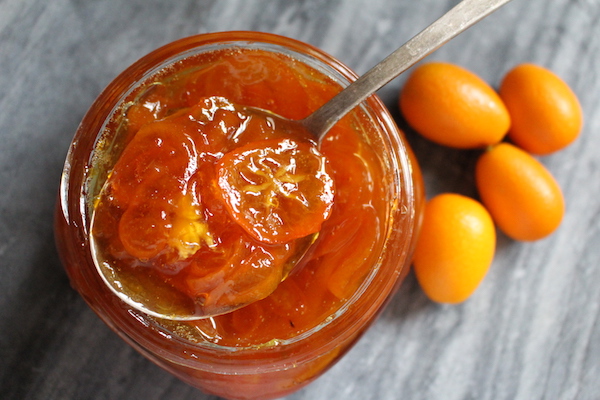
The first time I tried kumquats was right off the tree in California. Even growing up among the citrus groves, I had never seen or heard of kumquats until high school. One afternoon my team was playing on a new field, and there was a giant kumquat tree hanging over the fence right into the dugout.
We were all curious about them but no one knew what they were. I plucked one off, carefully peeled it and got the surprise of my life. SO incredibly tart!
What I didn’t know was kumquats are eaten whole, peel and all. The inside is very tart, but the skin is mild and sweet. Together they’re a treat with a bit of zing, but without the peel, it’s sour enough to make your eyes water.
When making homemade kumquat preserves, that begs the question, is it a jam or a marmalade? Generally, marmalade is a citrus-based spread that includes peel to add subtle tart/bitter notes to balance the sweetness. But what happens if it’s a type of citrus where the peel isn’t bitter, and you can’t reasonably eat the fruit without the peel?
I call it kumquat jam, you can call it kumquat marmalade if you like, but my kids…they call it delicious.
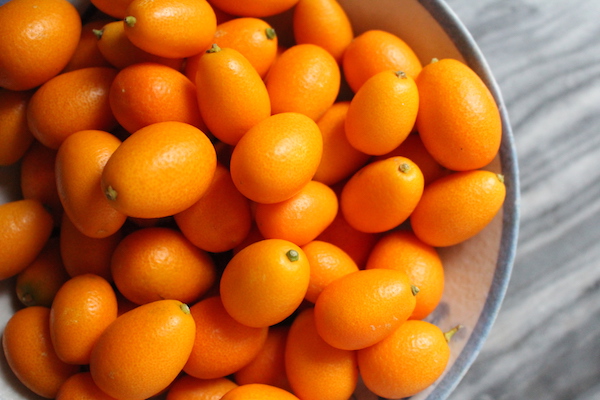
There are a few different ways to prepare kumquats for kumquat jam, but regardless of the method, the peel is always central to the preserve. In my method, I simply slice the kumquats across the equator, which leaves full rounds of the tiny fruits in the finished jam.
I’ve seen other methods that slice the fruits into strips vertically, cutting them into eighths. That leaves you with thin 1” slices of peel throughout the jam almost like confetti, and that gives a look much more like a traditional marmalade.
Since I want to really play up the uniqueness of these tiny fruits, I find the rounds make for a striking presentation. There aren’t any other citrus fruits tiny enough to cut into rounds for jam, so this kumquat jam catches your attention.
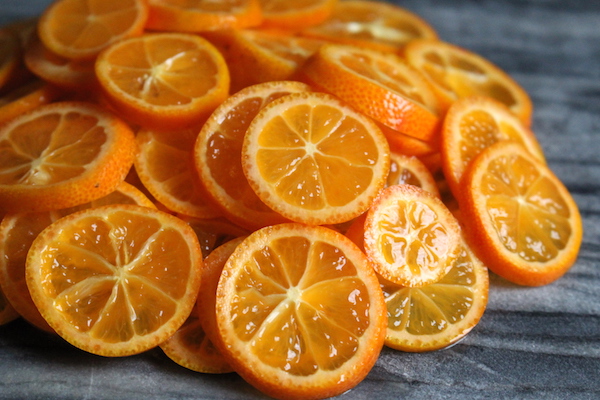
Beyond their tartness, another surprising thing about kumquats is the seeds. For such a small fruit they have some impressively large seeds. Those will need to be removed before the slices go into the jam.
As you’re slicing the kumquats, you’ll find a pocket of seeds towards the center. Simply use the tip of your knife to pull them out and set them aside.
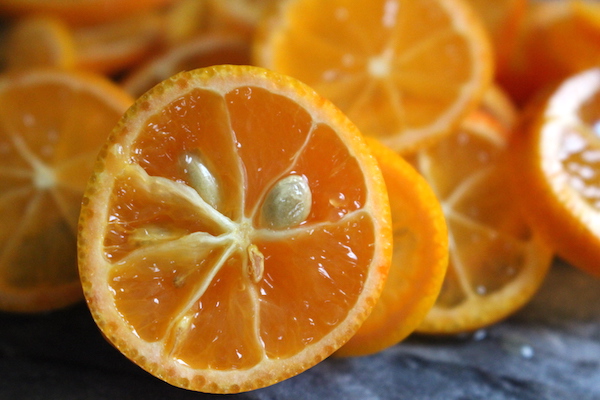
Now you’ll notice I said “set the seeds aside” not “toss the seeds in the compost.” The seeds are actually important to this jam, believe it or not!
Citrus fruits contain quite a bit of pectin naturally, and the seeds have some of the largest concentrations. Those large kumquat seeds are the source of pectin for this jam, and they’ll help it thicken up beautifully without any store-bought pectin.
The trick is, while you need the seeds in the jam pot as a thickener, you don’t want them in the finished jam. Wrapping the seeds up in a bit of cheesecloth means you can put them into the boil as a pectin source, but then remove them towards the end for a clean seedless kumquat jam.
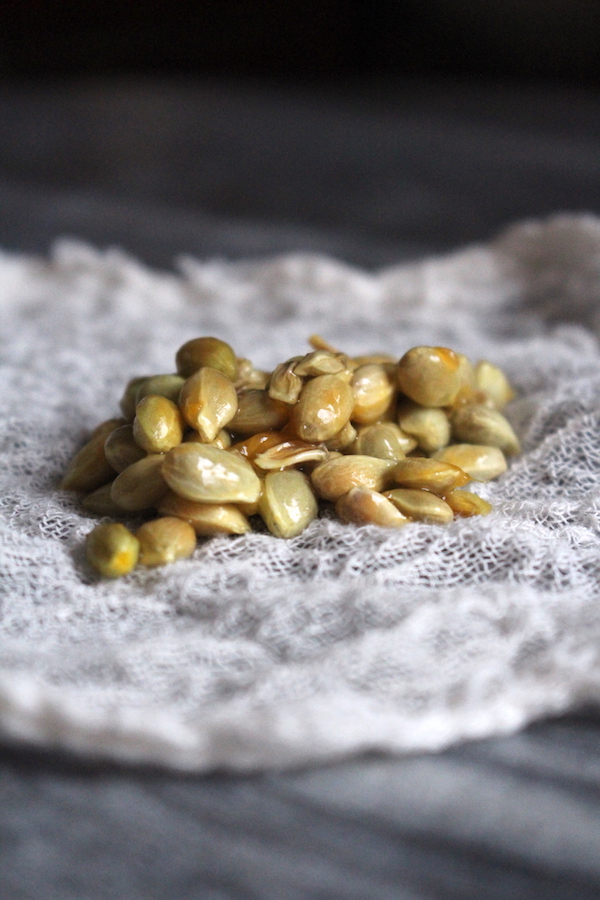
I’ve read that you can also place the citrus seeds in water overnight and they’ll cause the water to gel. That gel can then be added to the jam, instead of the seeds in a cheesecloth packet. I haven’t tried that method yet because I always have plenty of cheesecloth on hand from my home cheesemaking.
The thing you do need to keep in mind though is this jam needs to sit for a while before boiling. All the kumquat slices and the packet of citrus seeds go into the pot with a bit of water, and then they need to soak for 3-4 hours before cooking. At least so they say.
I’ve tried making kumquat jam the inpatient way, and just turned it on and started boiling. It does work and it will gel, but the yield is slightly lower since there’s less pectin. It’s harder to make a low sugar kumquat jam that way since in a low sugar jam the yield is already lower.
If you’re pressed for time and want to just get to it, go ahead. Just keep in mind your last jar of jam might not be all the way full, and you should probably use the full amount of sugar.
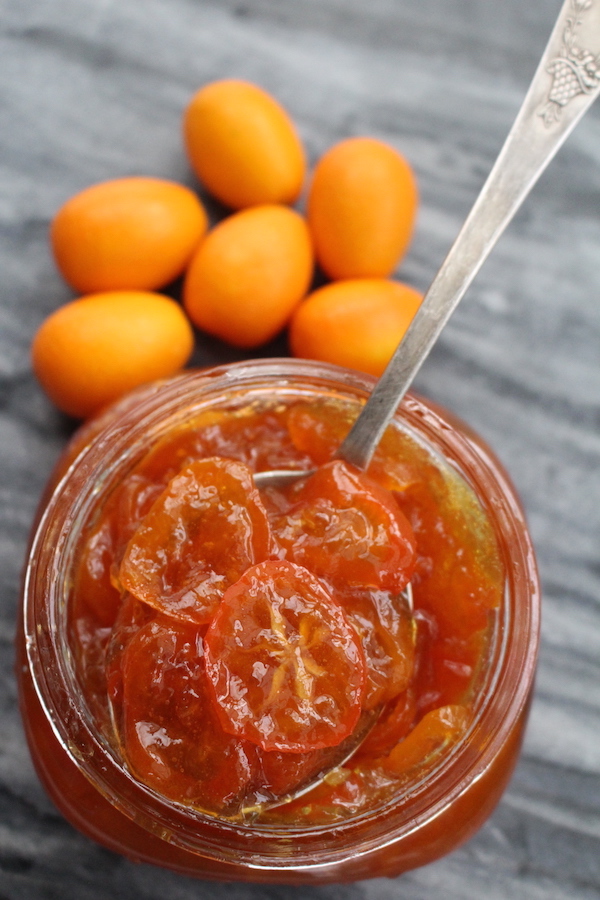
Sugar Amounts for Kumquat Jam
The amount of sugar in this jam recipe is a matter of preference. Just like any fruit, kumquats can be really tart or only mildly tart, depending on their source.
If you have fruit that is pretty sweet to start with, less sugar might be a good choice. Likewise, if you have very tart fruit (or like very sweet jams) more sugar is always an option.
I’ve seen some kumquat jam recipes that use 2 cups of kumquats and 8 cups of sugar, and in my mind, that’s just way over the top. At that point, you’re making candy, and the fruit is just in there for color.
This recipe has 2 cups of fruit and 1 cup of sugar, or roughly 1/8th the amount of some you’ll find. Still, I find it pretty darn sweet, and only ever so slightly tart, just enough to taste the fruit. I’d make it like this for my mom, who has a pretty good sweet tooth.
For myself, I’d reduce the sugar further to 1/2 cup of sugar for 2 cups of sliced kumquats. That reduces the yield a bit but suits my tastes better.
Either way, the jam gels just fine since the citrus seeds are in there adding extra pectin and helping to bring everything together. Regardless of the amount of sugar you choose, cook the jam to gel stage (220 degrees F) or test it for consistency on a plate kept in the freezer before pouring it into canning jars.
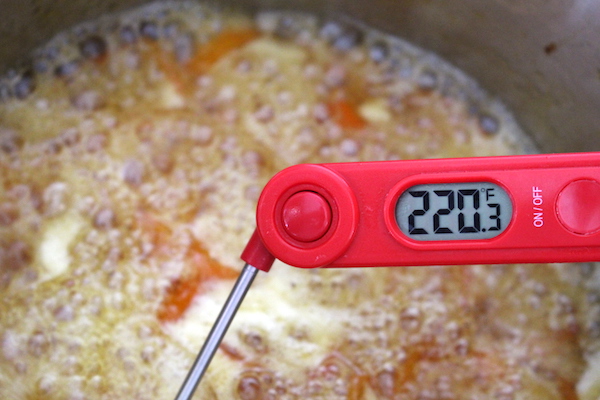
If you’re at a higher altitude, gel stage adjusts a bit.
For every 500 feet above sea level, drop 1 degree from the jam finished temperature. For example, at 1000 feet gel stage is actually 218 degrees instead of 220.
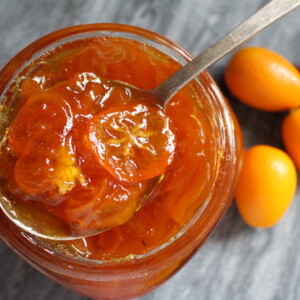
Kumquat Jam
Equipment
Ingredients
- 2 cups sliced kumquats, roughly 3/4 lb
- 3 cups water
- 1 cup sugar, see note
Instructions
- Slice the kumquats into thin slices horizontally across their equator, removing any seeds and setting them aside.
- Wrap the seeds in a bit of cheesecloth, tie it up and place them in the jam pot.
- Add in 3 cups of water and the sliced kumquats.
- Allow the fruit and water to sit for 3-4 hours, so that some of the pectin can extract into the water (this step can be skipped for a slightly lower yield).
- Turn on the pot and bring the mixture to a simmer. Cook for 35 to 45 minutes, adding a bit of water if necessary. At this point the jam should be starting to thicken.
- Remove the packet of citrus seeds and add sugar.
- Simmer the jam for another 5-10 minutes until the jam reaches gel stage (220 degrees F) or gels promptly when a bit is placed on a plate that's chilled in the freezer.
- Funnel into prepared canning jars, remove air bubbles and apply 2 part canning lids.
- Either store in the refrigerator for immediate use, or process in a water bath canner for 10 minutes to make the jam shelf stable.
Notes
Nutrition
Nutrition information is automatically calculated, so should only be used as an approximation.
More Citrus Preserving Recipes
- Canning Lemons 3 Ways
- Simple Orange Jam
- 20+ Ways to Preserve Lemons
- Homemade Limoncello Liqueur
- Salt Preserved Lemons
- Lemon Wine
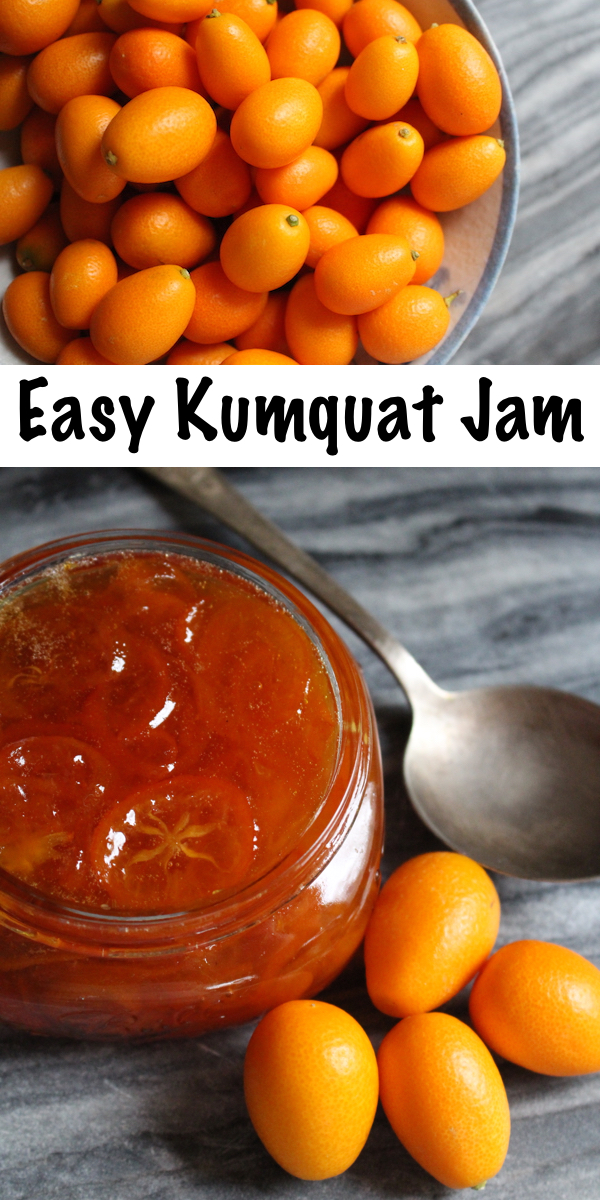
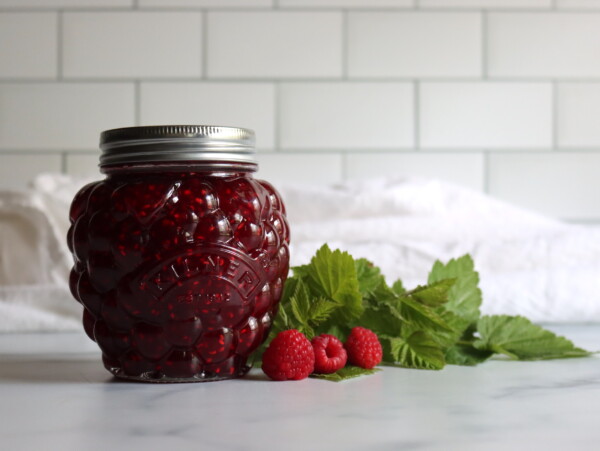
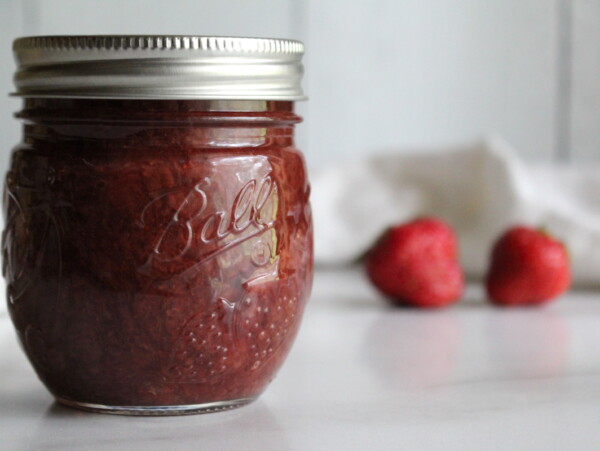
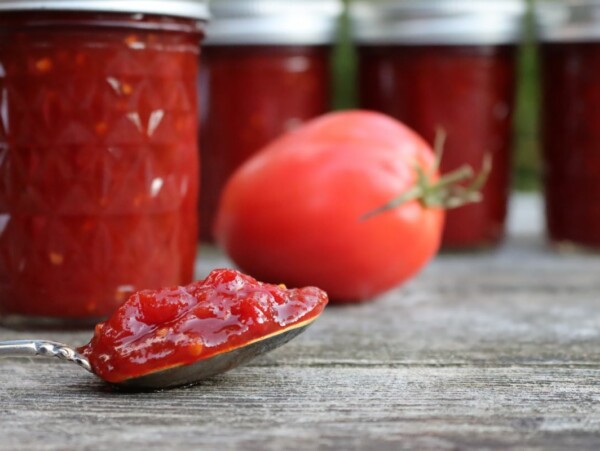
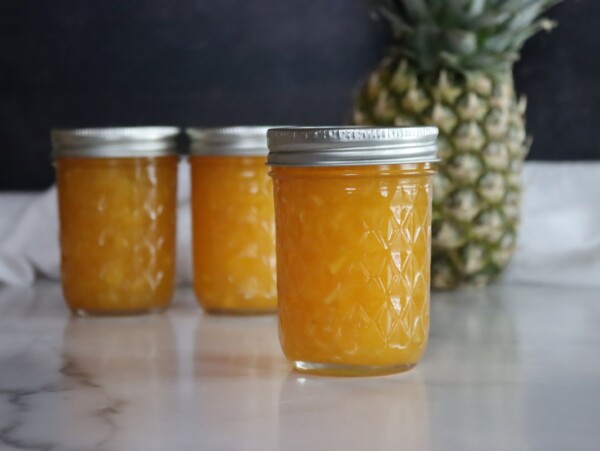
I absolutely love this recipe, seen so many, but definately too much sugar. And the kumquat rings caught my eye. Love, love, love
Thank you for this recipe!
Regards
Elsie Scott from South Africa
So glad you loved it!
Thanks for sharing this recipe. I’ve made it a few times now. And every time, it’s taken a while to set. And with all that time boiling, the color is more brown than that lovely deep orange. The taste and consistency is on point. But, what can I do differently to get that brighter color?
Hmmm, that is a good question. Two things you can try.
First, use white cane sugar (instead of organic or evaporated cane juice). There’s a bit of molasses in the nice stuff, and it can turn preserves brown in long cooks. If you are using white sugar, then I’d guess the kumquats you’re using are a bit lower in pectin than mine. It can help to use a marmalade technique instead.
Try my recipe for kumquat marmalade, which uses a bit of orange peel in there to help it set: https://creativecanning.com/kumquat-marmalade/
Do you think you could use honey in place of sugar? I have TONS of both.
You could definitely use honey but you would probably want to use a low sugar pectin.
I made this recipe and like many of you my jam didn’t set. I was simmering it after adding the sugar and it didn’t get hot enough. You have to bring it to a rolling boil at the highest setting on your stove to reach 220F. I did this in the end and my jam set, but was somewhat overcooked. It’s tasty and a lovely color. I would suggest changing the word simmer to rolling boil after adding the sugar to help clarify the recipe.
Are you supposed to simmer with or without the lid on? That detail may be why people are getting different results. Unfortunately, I put the lid on and it is very watery currently at the second simmer stage.
The lid should be off. When you’re simmering jam, part of the process is meant to cook off the excess liquid. I would say that in general if a recipe doesn’t specifically tell you to cover the pot that you should keep the lid off.
I had a 9 lb yield of kumquats from our tree. So first I made 1x the recipe, then 2x, then 3x and tomorrow I will finish them up with 4x the recipe. The jam is delicious. However, I had to cook it a long time to reach 220 degrees, even with 1x the recipe. At 3x, after the initial 45 minute cook (I actually did 50), I added the sugar and cooked it for an additional hour to get it to reach 220 degrees. I got five 1/2 pint jars of jam. For 1x the recipe I used 3/4 cup sugar, used 1-1/2 c for 2x, and 2-1/4 c for 3x., I added a cinnamon stick during the soaking and first stage of cooking which added quite a nice taste. This is a great recipe, just be aware that cooking times may vary.
Can I ask why the sugar is only added after the boiling tine? I’ve always added the sugar from the beginning of the cooking process for jams.
It depends on the type of fruit that you are using. Tough skinned fruits are often simmered before adding the sugar to soften the skins.
We just tried this recipe ( my son got a bag of kumquats ) and we’re almost done simmering. I am noticing the mixture seems watery and hoping this congeals a bit when it cools.
Yes, the mixture should thicken as it cools.
Can I freeze this jam? I usually make freezer jam which you don’t have to cook.
But will it freeze well?
I haven’t personally tried it but I don’t see why it wouldn’t work.
I doubled the recipe, using 2 lbs of kumquats and 6 cups of water. I also soaked the seeds and fruit for almost 5 hours before cooking as directed and put the jam in a 10 min water bath for 10 mins. That was last night. This morning, the jam is still very watery.
Should I reprocess to cook off some of the water?
Maybe turn up the flame from a simmer to a light boil?
If you suggest adding pectin, how much?
Doubling the recipe most likely affected the gel in the jam. It’s often better to do individual batches rather than a double batch in order to ensure that it cooks down properly. I wouldn’t recommend turning the heat up. You will most likely end up burning the jam instead. You can definitely reprocess the jam. Always wait 24-48 hours before doing so though because sometimes the extra time will allow it to set. You don’t want to recook more than 8 cups at one time. For every 4 cups of jam, you can mix together 1/4 cup of sugar and 1 Tablespoon of powdered pectin if you choose to use it. Add this mixture to your jam when you cook it.
The info on other recipes is very helpful. How to cut the kumquats was a great tip. However, please half the amount of water as it is way too much and dilutes the flavor.
Thank you for this wonderful recipe! My jam has a beautiful consistency and flavour! Not too stiff, not too runny, but just right! I could spoon it in like pudding. Addictive. I let my fruit sit in water with the pip-bag for 4 hours and added the full amount of sugar as per recipe, but had to boil my jam for about half an hour until it gelled on the plate. I think various factors influence the gelling stage, so taste your jam if you add less sugar at first and do the plate test. If it’s not sweet enough, add a little more sugar. If it’s not gelling, let it cook some more. Patience is key! 🙂
I used Meiwa kumquats from my tree. I too thought the 3 cups of water was too much initially but it did thicken and the
jam was better than any I’ve had. Use the seed pouch in the first boil and just simmer “forever” in the second boil for heaven on toast. Thanks fopr this.
You’re very welcome. So glad you enjoyed it.
What if instead of water i add brandy. And then instead of cooking it i just blend it. I feel like that would turn down the color intensity but the flavor would be even more fantastic.
You could certainly try it. It wouldn’t really be jam then. Let us know if you decide to give it a try.
I made this last year and it came out wonderful. I even doubled the recipe. I have a new batch of kumquats ready to go!
This is the best. Thanks so much for the wonderful recipe.
You’re so welcome. We’re glad you enjoyed the recipe.
I’ve made this several times and it’s great! Today I made it and my jam never did set up. It’s yummy, but very runny. I used the same amounts of ingredients. Wonder why?
Maybe you just needed to cook it longer.
Delicious! Like others commented, mine was too runny even after significant additional time of boiling. Next year, I will try making this with 2 cups of water. which seems to be a compromise from the 3 cups in this recipe and 1 cup I’m seeing in others. Also, as much as I love the visual of the kumquat rings, I also found them a little fragile so may consider cutting the kumquats into 8ths around the circumference.
For funsies (definitely not necessary but had these items lying around), I added a little grated ginger (1/2 in) and also steeped 1 star anise after adding the sugar.